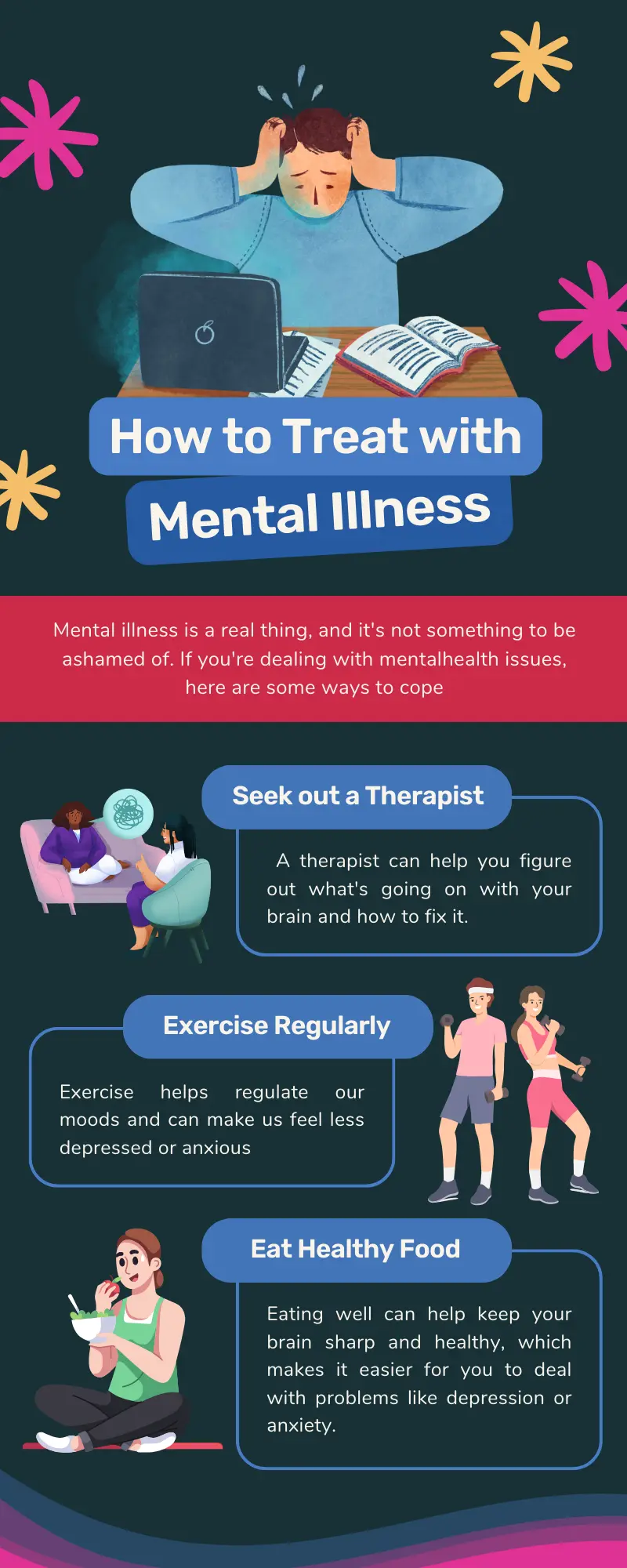Yes, is body dysmorphia a mental illness? It is a mental health problem characterized by a distorted body image and repeated states of anxiety and stress due to perceived deficiencies, even if these appear normal to others.
People with BDD may have negative body image and worry about their appearance, which can lead to mental illnesses such as depression and eating disorders. The disorder usually begins in adolescence and can result in excessive self-confidence, avoidance of social situations, and repetitive behaviors such as excessive personal grooming or seeking comfort from others.
If left untreated, BDD can lead to severe depression, anxiety, and suicidal thoughts.Be sure to see a doctor if you or someone you know has symptoms of BDD.
Understanding Is Body Dysmorphia a Mental Illness? This Psychological Condition
Yes, Is Body Dysmorphia A Mental Illness disorder (BDD) is a mental illness that affects the perception of physical appearance. People with BDD are concerned about perceived flaws in their appearance that are minor or unnoticeable to others. This worry can cause significant anxiety and interfere with daily functioning.
BDD is classified as obsessive-compulsive disorder and related disorders in the Diagnostic and Statistical Manual of Mental Disorders (DSM-5). It is estimated that BDD affects between 1.7% and 2.4% of the general population.
Psychotherapy, medication, or a combination of both can be effective in treating BDD.If you or someone you know is suffering from BDD, it is important to seek help from a mental health professional.

Defining Body Dysmorphia: An Overview
Is Body Dysmorphia A Mental Illness disorder (BDD) is a mental illness that causes a person to obsess over perceived flaws in their appearance. It is also known as body dysmorphia, mental illness or dysmorphic syndrome. People with BDD may spend several hours a day hiding or correcting perceived flaws, which can interfere with daily life and cause significant stress.
BDD affects people of all ages, genders and ethnicities. It is estimated that 1.Between 7% and 2.4% of the general population suffers from BDD. This condition often occurs concurrently with other mental health problems such as depression, anxiety, and obsessive-compulsive disorder (OCD).
Treatment for BDD usually involves a combination of medication and psychotherapy. Antidepressants and anti-anxiety medications may be prescribed to relieve symptoms.Cognitive behavioral therapy (CBT) is often used to help people with bipolar disorder learn to manage their symptoms and improve their self-esteem.
If you or someone you know suffers from BDD, it is important to seek help from a mental health professional. They can make an accurate diagnosis and develop a treatment plan tailored to your individual needs.
Symptoms and Diagnostic Criteria
The term “diagnostic criteria” refers to the specific combination of signs, symptoms and test results by which a doctor attempts to make a correct diagnosis. Diagnostic criteria are also called clinical case definitions. Examples of diagnostic criteria are the Amsterdam criteria for hereditary colorectal carcinoma without polyposis.
Prevalence and Demographics
I’m not sure what you’re asking. Can you explain what you mean by “prevalence and demographics”? Want to know the prevalence and demographics of a particular topic? If yes, tell me what topic interests you. 😊
Body Dysmorphic Disorder vs. Everyday Insecurities
Is Body Dysmorphia A Mental Illness (BDD)? It is a psychological problem that causes a person to have a distorted view of their appearance. People with BDD may spend many hours each day trying to hide or correct perceived flaws that are minor or imperceptible to others.This can cause significant stress and affect daily functioning.
On the other hand, everyday insecurities are common and normal. Everyone has things they don’t like about their appearance, but they don’t necessarily affect their daily life. It’s important to remember that everyone has flaws and that uncertainty is okay.
If you are concerned about your appearance or suspect that you may have BDD, it is important to speak to a mental health professional.They will help you understand your symptoms and provide you with treatment options.
Causes and Contributing Factors
Is body dysmorphia a mental illness? It is a complex problem that has no single cause.However, several factors can contribute to the risk of developing mental illnesses. These include:
♻️ Genetics: Mental illnesses can be hereditary, indicating a genetic predisposition.
Trauma: Traumatic experiences such as physical, emotional or sexual abuse, neglect or violence can increase the risk of mental illness.
♻️ Brain Chemistry: Chemical imbalances in the brain can lead to mental illness.
Environmental Factors: Exposure to toxins, poor nutrition, and lack of access to health care can contribute to the development of mental illness.
♻️ Life Experiences: Stressful life events such as divorce, job loss or the death of a loved one can trigger mental illness in some people.
It’s a medical condition that requires treatment and support from healthcare professionals and loved ones.
If you or someone you know is struggling with mental health issues, it’s essential to seek help from a qualified healthcare professional.
The Intersection of Body Dysmorphia and Eating Disorders
Is Body Dysmorphia A Mental Illness and an eating disorder that can occur at the same time. Body dysmorphia is a serious condition in which obsessive and intrusive thoughts revolve around certain parts or areas of the body that are perceived as distorted or grotesque in some way.
Eating disorders typically focus on size, shape, and weight, while body dysmorphia typically focuses on a specific part of the body, such as: B. the nose, the muscle mass, the hairline or the stomach.
People with body dysmorphia and eating disorders often perceive themselves as too fat or overweight and engage in anorexic or bulimic behaviors to control their weight.
Effect Of Sleep On Academic Performance 2023 Benefits!
Effects on Is Body Dysmorphia A Mental Illness and Quality of Life
I’m assuming you’re asking about the effects of mental health on quality of life. Mental health can have a significant impact on a person’s quality of life.
Poor mental health can have a number of negative consequences, including reduced quality of life, reduced productivity and increased risk of physical illness.
Many factors can contribute to poor mental health, including stress, trauma and social isolation.
Diagnosing Body Dysmorphic Disorder
Is Body Dysmorphia A Mental Illness disorder is a mental disorder (BDD), a mental illness that causes a person to have a distorted view of their appearance and spend a lot of time worrying about their appearance. It can affect people of all ages, genders and ethnicities.
The symptoms of BDD can be similar to those of other mental disorders such as depression and anxiety.If you think you have BDD, it is important to talk to your doctor or mental health professional. They help make the correct diagnosis and treatment.
Treatment Options: Therapy and Medications
Various treatment options are available for various psychological problems.The two most common treatment options are therapy and medication.
Therapy is a form of treatment in which you speak to a psychologist to help you manage your symptoms. Is body dysmorphia a mental illness? There are different types of therapies such as cognitive behavioral therapy (CBT), dialectical behavior therapy (DBT), and psychodynamic therapy, among others. The type of treatment recommended depends on the person’s specific needs and the nature of their mental health problem.
Medications can also be used to treat psychological problems.Several types of medications are available, including antidepressants, antipsychotics, mood stabilizers, and anxiolytics. The type of medication prescribed depends on the person’s specific needs and the nature of their mental health problem.
It is important to remember that treatment for mental illness is not universal. It is important to work with a mental health professional to determine the best treatment for your specific needs.
Living with Body Dysmorphia: Coping Strategies
Is Body Dysmorphia A Mental Illness (BDD)? It is a psychological problem that causes a person to have a distorted view of their appearance.Living with BDD can be difficult, but there are several coping strategies that can help you manage the symptoms.
Cognitive behavioral therapy helps people recognize and change negative thought patterns and behaviors related to their appearance.
Mindfulness-Based Stress Reduction (MBSR) is another technique that can help treat BDD symptoms.MBSR involves practicing mindfulness meditation and yoga to reduce stress and anxiety.
Self-care is also essential when living with BDD. Engaging in activities that promote relaxation, such as taking a warm bath or reading a book, can help reduce stress and anxiety.
It’s important to work with a mental health professional to determine the best course of treatment for your specific needs.
Support Systems: How Friends and Family Can Help
✅ Listening: Sometimes someone just needs one ear to listen. Be there for them and let them know you are there to support them.
✅ Offer emotional support: Let your loved one know that you care and that you are there to help them in difficult times.
✅ Help with practical tasks: Offer help with tasks such as cooking, cleaning or shopping. This can be especially helpful if your loved one is going through a difficult time.
✅ Encourage professional help: If your loved one is struggling with mental health issues, encourage them to seek professional help. You can offer to help them find a therapist or other america mental health professional.
Remember that supporting someone through a difficult time can be challenging. It is also important to take care of yourself. Don’t hesitate to ask for help if you need it.
Breaking the Stigma: Raising Awareness and Promoting Body Positivity
Ending body image stigma is an important issue that has received a lot of attention in recent years. Body positivity is a movement that aims to promote self-love and acceptance of all body types, regardless of shape, size or appearance. It encourages people to accept their bodies and celebrate its unique characteristics.
There are many ways to raise awareness and promote body positivity.One solution is to challenge the unrealistic beauty standards often presented by the media. This can be achieved by portraying different body types in advertisements, films and television shows.
Another option is to encourage people to share their stories and experiences with body image. It can help others feel less alone and more confident.
It is important to remember that everyone’s body image development is different and there is no one-size-fits-all solution.However, by promoting body positivity and eliminating the stigma surrounding body image, we can create a more inclusive and welcoming society.
If you would like to learn more about this topic, here are some resources that might be helpful to you:
🍃 National Eating Disorders Association: Nonprofit organization providing support and resources to people with eating disorders.
🍃 Body Positive: A website with information and resources about body positivity.
🍃 The Body Is Not an Apologia: A website that promotes radical self-love and body empowerment.










